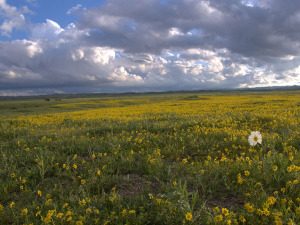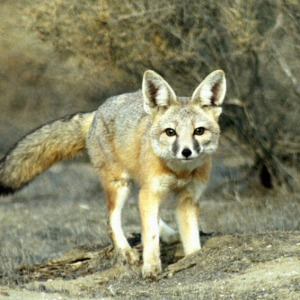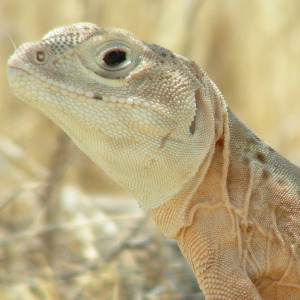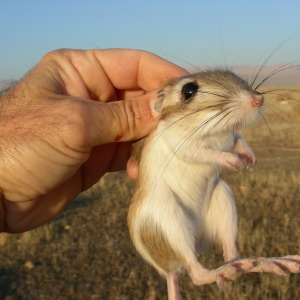


Area: 3,900acres
Location: Buttonwillow, Kern County, California
Date Acquired: 1995-2008
Acquisition Type: Center for Natural Lands Management owns the preserve. We protect and manage species and habitats on the preserve in perpetuity.
Key Habitats: Alkali Desert Scrub, California Annual and Perennial Grassland
Species of Special Interest to CNLM: San Joaquin kit fox (Vulpes macrotis mutica), Giant kangaroo rat (Dipodomys ingens), Tipton kangaroo rat (Dipodomys nitratoides nitratoides), San Joaquin antelope squirrel (Ammospermophilus nelsoni), Blunt-nosed leopard lizard (Gambelia sila), Kern mallow (Eremalche kernensis)
Introduction
The Lokern Preserve was created between 1989 and 2008, primarily using mitigation funds associated with development projects under regulatory authority of the California Energy Commission, U.S. Fish and Wildlife Service, and the California Department of Fish and Wildlife (CDFW). This 3,900-acre Preserve is composed of several disjunct parcels along both sides of the California Aqueduct, approximately 30 miles west of Bakersfield, California. These parcels were acquired to provide quality habitat for several threatened and endangered species, including: San Joaquin kit fox (Vulpes macrotis mutica), giant kangaroo rat (Dipodomys ingens), Tipton kangaroo rat (Dipodomys nitratoides nitratoides), San Joaquin antelope squirrel (Ammospermophilus nelsoni), blunt-nosed leopard lizard (Gambelia sila), and Kern mallow (Eremalche kernensis).
Conservation Significance
 Much of the Preserve is comprised of valley saltbush scrub, which is dominated by two species, spiny saltbush (Atriplex spinifera) and common saltbush (Atriplex polycarpa). In areas of heavy clay soils east of the California Aqueduct, saltbush scrub grades into valley sink scrub, where iodinebush (Allenrolfea occidentalis) and seepweed(Suaeda moquinii) become morecommon. Previous wildfires on the west side of the California aqueduct have converted much of the valley saltbush scrub into an open grassland, where shrub cover remains at low levels. Common herbaceous species include Arabian grass (Schismus barbatus), red-stemmed filaree (Erodium cicutarium), popcorn flower (Plagiobothrys spp.), pygmy stonecrop (Crassula connata), red brome (Bromus madritensis ssp. rubens), combseed (Pectocarya penicillata), fiddleneck (Amsinkia menziesii), and pepperweed (Lepidium spp.). After a series of wet years, nonnativegrasses can become relatively dense and dominate the herbaceous vegetation. The Lokern Preserve provides habitat for a variety of additional species of concern, including burrowing owl (Athene cunicularia), LeConte’s thrasher (Toxostoma lecontei), tri-colored blackbird (Agelaius tricolor), short-nosed kangaroo rat (Dipodomys nitratoides brevinasus), and Tulare grasshopper mouse (Onychomys torridus tularensis).
Much of the Preserve is comprised of valley saltbush scrub, which is dominated by two species, spiny saltbush (Atriplex spinifera) and common saltbush (Atriplex polycarpa). In areas of heavy clay soils east of the California Aqueduct, saltbush scrub grades into valley sink scrub, where iodinebush (Allenrolfea occidentalis) and seepweed(Suaeda moquinii) become morecommon. Previous wildfires on the west side of the California aqueduct have converted much of the valley saltbush scrub into an open grassland, where shrub cover remains at low levels. Common herbaceous species include Arabian grass (Schismus barbatus), red-stemmed filaree (Erodium cicutarium), popcorn flower (Plagiobothrys spp.), pygmy stonecrop (Crassula connata), red brome (Bromus madritensis ssp. rubens), combseed (Pectocarya penicillata), fiddleneck (Amsinkia menziesii), and pepperweed (Lepidium spp.). After a series of wet years, nonnativegrasses can become relatively dense and dominate the herbaceous vegetation. The Lokern Preserve provides habitat for a variety of additional species of concern, including burrowing owl (Athene cunicularia), LeConte’s thrasher (Toxostoma lecontei), tri-colored blackbird (Agelaius tricolor), short-nosed kangaroo rat (Dipodomys nitratoides brevinasus), and Tulare grasshopper mouse (Onychomys torridus tularensis).
This Preserve is part of the Lokern Natual Area (LNA), which includes over 30,000 acres of high-quality habitat for various wildlife and plant species of the San Joaquin Valley. Other owners with protected lands within the LNA boundaries include CDFW, Bureau of Land Management, Plains Exploration Company, and Occidental Petroleum. Chevron also is preparing a habitat conservation plan that may result in the protection of several thousand acres within the LNA.
Our Work
Management of the Lokern Preserve is the responsibility of CNLM. The overall goal at Lokern is to maintain a functioning ecosystem that supports the threatened and endangered species for which the Preserve was established. Since most of these species are desert-adapted, special emphasis is placed on maintaining a relatively sparse herbaceous cover.
In wet years, CNLM enters into grazing agreements with local livestock operators to create a more open habitat structure favored by these species. On previously burned lands, native shrubs also are being re-established. In addition, a multi-year study was recently initiated to determine the usefulness of a grass-specific herbicide in reducing competition between Kern mallow plants and nonnative grasses. A suite of trophic levels is monitored annually on the Preserve to provide increased understanding of the system and to evaluate the success of management strategies.
Public Access
Please contact the preserve manager for information about public access.
Contact
For more information about Lokern Preserve or Center for Natural Lands Management, please contact Greg Warrick, Preserve Manager at gwarrick@cnlm.org or 760.731.7790 extension 202




